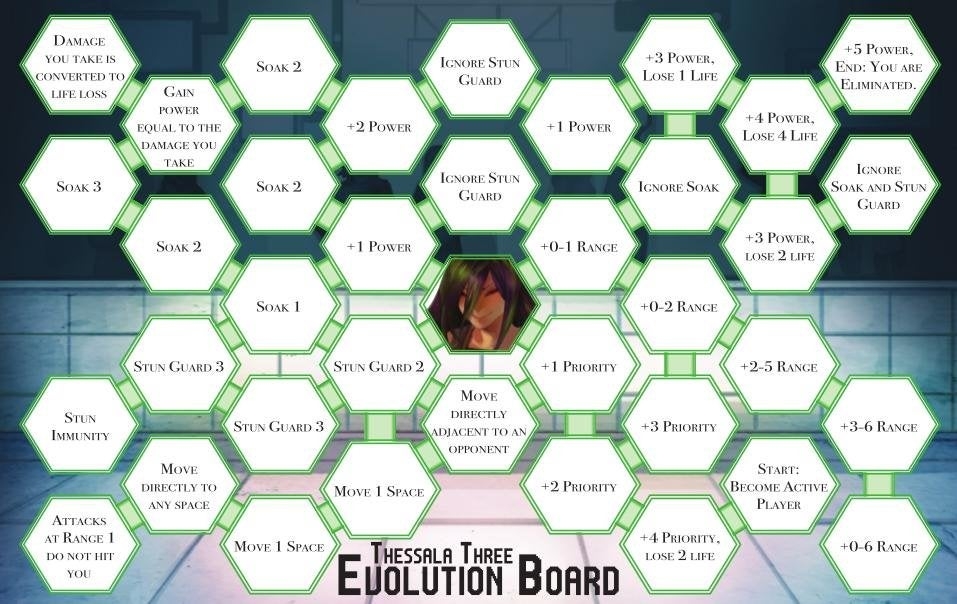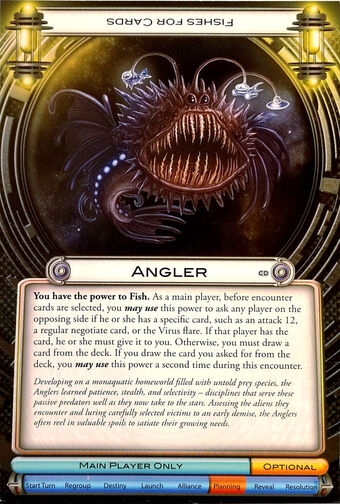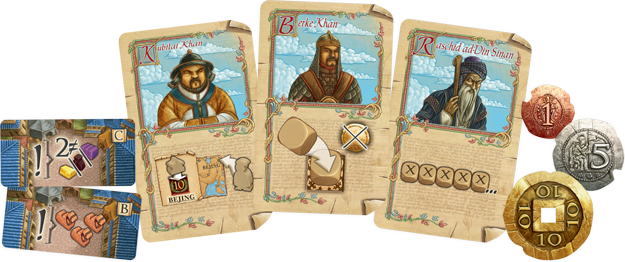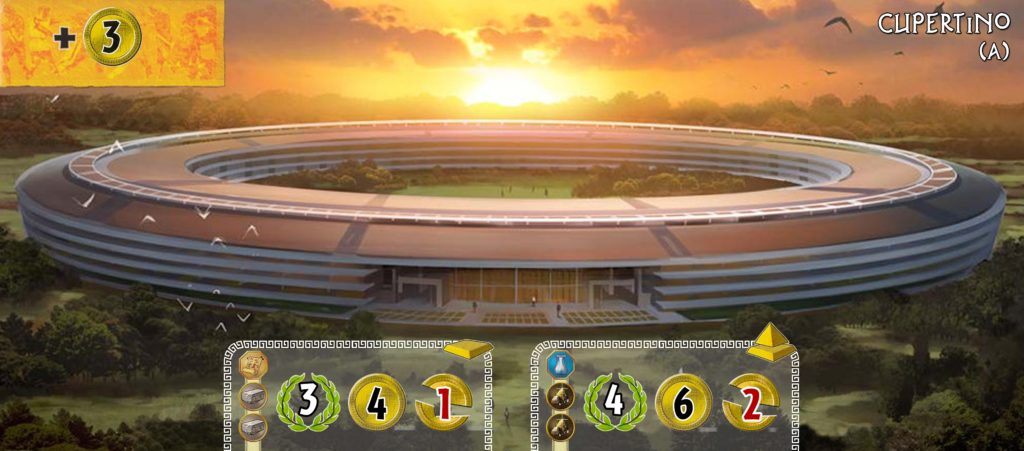Asymmetric powers are a tried-and-true method to spice up a tabletop game design. I’ve already written about asymmetry in general in a previous article; the short of it is though I don’t think player powers make a game more “strategic”, they have many advantages that allow players to have more fun playing the game.
However, not every power is created equal. Even when compared to other powers within the same game, some powers are more exciting, memorable, and interesting. In short, they’re more impactful. In this article, I’ll be using four case studies from various games well known for their player powers to examine what makes an especially impactful power stand out, and how you can apply this to your game designs.
The Voyages of Marco Polo: Raschid ad-Din Sinan and Kublai Khan
Player powers either break preëxisting rules of the game or give you bonuses for certain game actions. The game The Voyages of Marco Polo is a masterclass in how to make exciting powers in the former category.
To explain how cool these powers are, here’s a very brief description of the game: Players are various historical figures recreating Marco Polo’s journey to Beijing. Each round, players roll five dice and then place them on the board in typical worker-placement fashion. The higher the value on your placed die, the stronger the action. One of the major actions is spending camels and other resources to make your player figure travel across the board, unlocking new powers by visiting cities. Beijing, the final city on the map, is worth a lot of points and unlocks three new actions.
Many of the eight player powers are what you’d expect from a Eurogame. Some give you extra resources, and others make some actions cheaper. Marco Polo and his dad, who share a character card for some reason, get two player figures. However, two powers in particular demolish our conceptions on how the game works on a fundamental level.
Let’s start with Raschid. As Marco Polo is a dice-placement game, the core of the game is improvising your moves based on the outcome of your dice rolls each round. Fitting the random – sometimes poor – results of the rolls with your game plan is a critical skill. Unless you’re Raschid, in which case you can just set your dice to whatever result you want. Imagine explaining the premise of the game, going into how critical it is that you figure out where to put your highest dice rolls, and then you hand a new player Raschid and tell them to forget all of that and set all their dice to 6 immediately!
While Raschid annihilates the concept of the core gameplay, Kublai Khan annihilates the core goal. While everyone else has to invest significant resources in making the painstaking trek to Beijing, he gets to start there! That’s right, all of those points and powers are just yours for the taking at the beginning of the game, and you get to quickly move in on the powerful cities on the right side of the board while everyone else is puttering around in the West. It’s a very simple power, and not even considered good by competitive players, but one that sounds amazing on paper.
Marco Polo teaches us two things: Break the basic rules of your game and make the powers sound strong (even if they aren’t). It’s not enough to break incidental rules, like the “no-duplicates” rule in 7 Wonders – the most impactful powers take something that players would consider a cornerstone of how the game operates and change it completely. Impactful powers also possess a kind of gravitas that makes them feel powerful, even if other powers that gain incidental resources are technically stronger in gameplay. A good goal to aim for is to make every power feel busted in half, but busted in ways that feel balanced against each other.
BattleCON: Thessala Three
BattleCON: Fate of Indines has 10 playable characters. Three of them are incredibly complicated to play, so that leaves seven that are appropriate for new players. Even given seven options, when I introduced Fate to a friend and asked them to choose a character, they went with Thessala Three over half the time. There could be several reasons for this, but I’m guessing the major one is she was the only character in the box to get an entire board all to herself.

Even in a game known for its huge number of characters with bizarre abilities, Thessala stands out by having such a prominent component that only she can use. From the moment you open the box and see this, you start getting curious about why only Thessala gets this “evolution board” and how it works. Compared to most of the other characters who only get special tokens at best, this feels like much more of a draw and is more likely to stick with you.
Thessala teaches us that unique components can go a long way. While having special components for every player power could get cost-prohibitive quickly, including large, flashy pieces that only one character gets access to creates a sense of intrigue that may even outclasses powers that have a larger effect on the game. Leder Games’ suite of fully asymmetric games, like Root, are excellent examples of games that use this principle to the fullest, only having enough unique factions for 4 or 5 players but each one having a long series of special powers and player boards.
7 Wonders: Cupertino
Games generally have a “mechanical palette” that comprises all the mechanics we could expect to see within its genre. We might expect the players to have to know trivia for party and trivia games, but if we were playing a wargame or engine-building Euro and we were suddenly asked about who’s buried in Grant’s tomb it throws us wildly off. Generally, to meet audience expectations for your game, it’s good to stay within your broad mechanical palette.
But what if a player power purposefully was to purposefully stray from its genre’s mechanical palette?
The Cupertino Wonder was originally released for 7 Wonders‘ companion app for the iPad. Though it looks innocuous, it has a very weird twist: The actual power changes depending on whether Apple stock is going up or down. While the other wonders in the game make for interesting, varied playstyles that put importance on different cards, this is the only one you could tell about to your friends and have them be genuinely interested.
Palette breaks usually involve including some kind of social element in a game that’s otherwise dedicated to strategy. In this sense, it isn’t appropriate for every game – it often creates a silly tone, so you have to use it for a game that doesn’t have a super serious aesthetic. It may also be better used for promotional or one-off components that players can choose or not choose to include. Many of Agricola: The Goodies‘ extra decks are silly and palette-breaking, but the expansion is generally aimed towards people who already know they like Agricola and want to spice it up a little.
Cosmic Encounter: Angler
Cosmic has so many different alien powers that I heavily considered just using four Cosmic aliens for this article, but I felt like a breadth of games would be more informative. So in a heroic attempt to not make this article just me gushing about Cosmic for 2000 words again, I restrained myself to talking about a single alien. That alien is the Angler.
Now, the Angler doesn’t do anything I mentioned the previous three case studies. It doesn’t break any rules, instead being a power that lets you steal cards from your opponents; it seems useful, but not particularly strong, let alone broken; it doesn’t have any special components whatsoever; and the ability falls well within the game’s mechanical palette. So why did I choose it?
I chose it because, while all the other aliens are playing Cosmic Encounter, it’s – literally – playing Go Fish.

The Angler shows us how we can make use of resonance. In this context, “resonance” refers to building off the audience’s preëxisting conceptions. There’s broadly two kinds of this. Cultural resonance builds off (typically pop) cultural artifacts. We already know that zombies are hard to kill and slowly, mindlessly move towards the nearest living creatures, so if we have a zombie character or enemy that acts like that we can point at it and say, “that’s a zombie!”
The other kind of resonance, and what the Angler uses, is mechanical resonance. Mechanical resonance makes use of a genre or mechanic that players are familiar with from other games, but in a different context. A good example is how Great Western Trail used the deckbuilding mechanics popularized by games like Dominion. Though the context for the deckbuilding mechanic is very different, players are familiar enough with it that it isn’t as much of a cognitive load on them.
Besides making it easier for players to access a game, mechanical resonance is very useful to creating impactful player powers, as evidenced by the Angler above. If you introduce a familiar mechanic as an asymmetrical player power, you’re igniting the neurons of your players who know the mechanic from other contexts and can tie it to their previous memories. In this way, you’re getting a lot of impact out of your game but the genre heavy hitters are doing most of the work!
Conclusion
If your game is a good fit for asymmetrical powers, following some or all of the guidelines above are helpful ways to see if your player roles are more than just balanced – that they’re memorable enough that your players will grow attached to them. By no means is this an exhaustive list, nor is every technique appropriate for every game, but I hope it’s at least a pillar around which you can build a system of evaluating your asymmetric powers.

